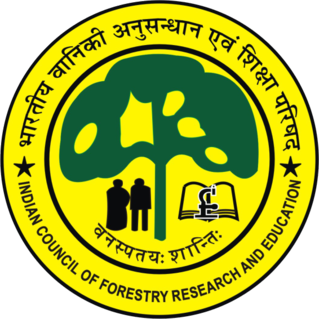Project Tiger is a wildlife conservation movement initiated in India to protect the endangered tiger. The project was initiated in 1973 by the Ministry of Environment, Forest and Climate Change of the Government of India. As of March 2024, there are 55 protected areas that have been designated as tiger reserves under the project. As of 2023, there were 3,682 wild tigers in India, which is almost 75% of the world's wild tiger population.
The Canadian Forest Service is a sector of the Canadian government department of Natural Resources Canada. Part of the federal government since 1899, the CFS is a science-based policy organization responsible for promoting the sustainable development of Canada's forests and competitiveness of the forest sector to benefit present and future Canadians. Some of the research areas that the CFS is involved in include; forest fire, climate change, silviculture, soils, insects and disease, remote sensing and forest management. Since 1991 the sector has produced an annual report, The State of the Forest in Canada, which describes the status of the nation's forests and the forest industry.

The Forest Research Institute is a Natural Resource Service training institute of the Indian Council of Forestry Research and Education and is an institution in the field of forestry research in India for Indian Forest Service cadres and all State Forest Service cadres. It is located at Dehradun in Uttarakhand, and is among the oldest institutions of its kind. In 1991, it was declared a deemed university by the University Grants Commission.

The Indian Institute of Forest Management (IIFM), founded 1982, is an autonomous, Natural Resource Service training institute of Forestry located in Bhopal, Madhya Pradesh, India, established by the MoEFCC, Government of India with financial assistance from the SIDA and course assistance from the IIM Ahmedabad for mid career training of IFS cadre and all State Forest Service cadre in India. The institute's objective is to fulfill the growing need for the managerial human resource in the area of Forest, Environment, and Natural resources Management and allied sectors. The institute is headed by a director selected and appointed by the Ministry of Environment, Forest and Climate Change, Government of India.

The Indian Council of Forestry Research and Education (ICFRE) is an autonomous organisation or governmental agency under the MoEFCC, Government of India. Headquartered in Dehradun, its functions are to conduct forestry research; transfer the technologies developed to the states of India and other user agencies; and to impart forestry education. The council has 9 research institutes and 4 advanced centres to cater to the research needs of different bio-geographical regions. These are located at Dehradun, Shimla, Ranchi, Jorhat, Jabalpur, Jodhpur, Bengaluru, Coimbatore, Prayagraj, Chhindwara, Aizawl, Hyderabad and Agartala.
Indira Gandhi National Forest Academy (IGNFA) is a forest service training institute under the Ministry of Environment and Forests of India, which was originally as Indian Forest College, established in 1938 for training of senior forest officers. It is situated in the New Forest campus of Forest Research Institute (FRI), Dehradun. IGNFA is currently functioning as a staff college for the officers of the Indian Forest Service (IFS).

The Ministry of Environment, Forest and Climate Change (MoEFCC) is an Indian government ministry. The ministry portfolio is currently held by Bhupender Yadav, Union Minister of Environment, Forest and Climate Change.

The Wildlife Institute of India (WII) is an autonomous natural resource service institution established in 1982 under the Ministry of Environment Forest and Climate change, Government of India. WII carries out wildlife research in areas of study like Biodiversity, Endangered Species, Wildlife Policy, Wildlife Management, Wildlife Forensics, Spatial Modeling, Ecodevelopment, Ecotoxicology, Habitat Ecology and Climate Change. WII has a research facility which includes Forensics, Remote Sensing and GIS, Laboratory, Herbarium, and an Electronic Library. The founder director was V. B. Saharia while the first director was Hemendra Singh Panwar who remained the director from 1985 to 1994. Trained personnel from WII have contributed in studying and protecting wildlife in India. The national tiger census or the All India Tiger Estimation, is done by WII along with NTCA and state forest departments.

Forestry in India is a significant rural industry and a major environmental resource. India is one of the ten most forest-rich countries of the world. Together, India and 9 other countries account for 67 percent of the total forest area of the world. India's forest cover grew at 0.20% annually over 1990–2000, and has grown at the rate of 0.7% per year over 2000–2010, after decades where forest degradation was a matter of serious concern.

The National Tiger Conservation Authority (NTCA) is a wildlife conservation agency formed to protect the endangered Bengal tiger in India. It was established by the Government of India in December 2005 for the management of Project Tiger and the various tiger reserves in India. As of 2023, there were 3,682 wild tigers in India, which is almost 75% of the world's wild tiger population.

The environment of India comprises some of the world's most biodiverse ecozones. The Deccan Traps, Gangetic Plains and the Himalayas are the major geographical features. The country faces different forms of pollution as its major environmental issue and is more vulnerable to the effects of climate change being a developing nation. India has laws protecting the environment and is one of the countries that signed the Convention on Biological Diversity (CBD) treaty. The Ministry of Environment, Forest and Climate Change and each particular state forest departments plan and implement environmental policies throughout the country.

Conservation in India can be traced to the time of Ashoka, tracing to the Ashoka Pillar Edicts as one of the earliest conservation efforts in the world. Conservation generally refers to the act of carefully and efficiently using natural resources. Conservation efforts begun in India before 5 AD, as efforts are made to have a forest administration. The Ministry of Environment, Forest and Climate Change is the ministry responsible for implementation of environmental and forestry program in India, which include the management of national parks, conservation of flora and fauna of India, and pollution controls.

Globally, Nepal is ranked fourth in terms of vulnerability to climate change. Floods spread across the foothills of the Himalayas and bring landslides, leaving tens of thousands of houses and vast areas of farmland and roads destroyed. In the 2020 edition of Germanwatch's Climate Risk Index, it was judged to be the ninth hardest-hit nation by climate calamities during the period 1999 to 2018. Nepal is a least developed country, with 28.6 percent of the population living in multidimensional poverty. Analysis of trends from 1971 to 2014 by the Department of Hydrology and Meteorology (DHM) shows that the average annual maximum temperature has been increasing by 0.056 °C per year. Precipitation extremes are found to be increasing. A national-level survey on the perception-based survey on climate change reported that locals accurately perceived the shifts in temperature but their perceptions of precipitation change did not converge with the instrumental records. Data reveals that more than 80 percent of property loss due to disasters is attributable to climate hazards, particularly water-related events such as floods, landslides and glacial lake outburst floods (GLOFs).
Van Vigyan Kendra (VVK) or Forest Science Centres (FSC) has been established by Indian Council of Forestry Research and Education (ICFRE) of the Ministry of Environment and Forests, Govt. of India. It intends to help disseminate various technologies developed by farmers, forest based industries and forest research institutes.

The Ministry of Environment, Forest and Climate Change is a ministry of the government of the People's Republic of Bangladesh whose role is ensuring the sustainable environment and optimum forest coverage. Ministry of Environment, Forests and Climate Change is an independent ministry of the Government of the People's Republic of Bangladesh. Its main function is to plan, promote, coordinate and monitor government activities related to the environment and forest. This Ministry was established to look after all environmental matters in Bangladesh, and the Ministry is a permanent member of the Executive Committee of the National Economic Council. The Ministry is a participant in the United Nations Environment Program (UNEP). The main functions of the Ministry include environmental conservation, survey of forest and environmental elements, prevention of environmental degradation and pollution control, afforestation and restoration of degraded areas, and overall protection of the environment. Previously the ministry's name was the Ministry of Environment and Forest. On 14 May 2018, the cabinet changed the name to Ministry of Environment, Forest and Climate Change.
National Natural Resources Management System is an integrated natural resource management system of India which aggregates the data about natural resources from the remote sensing satellites and other conventional techniques. One of the important elements of this management system is the National Resource Information Systems which acts as feeder information system to the larger information system of the Government, which includes socioeconomic information and models. NNRMS activities are co-ordinated at the National level by the Planning Committee of NNRMS (PC-NNRMS) which frames guidelines for implementation of the systems and oversees the progress of remote sensing applications for natural resources management in the country.












